|

|
3-1 Crossing collisions covered in the analysis
Crossing collisions involving mopeds (114 cases) are extracted from our in-depth study database on traffic accident case studies conducted between 1995 and 2004. As Party 2 mopeds are the most frequently involved in traffic accidents according to our statistical study database described in the preceding section, the focus is placed on the analysis of mopeds as Party B*4.
*4: - In our in-depth study database, "Party A" refers to the driver of the vehicle involved in a traffic accident who committed the error that triggered the accident, while "Party B" refers to the other party involved. (These terms are not the same as "primary party" and "secondary party" used in our statistical study database)
- "Error" means an oversight or inappropriate judgment. This term also includes the failure to avoid a possible accident (i.e., defensive driving) even after recognizing the presence of the other party.
|
3-2 Analysis of human factors in crossing collisions involving mopeds
The actions of a driver are a continuous process of recognizing the presence of objects, making appropriate judgment, and acting (operating the vehicle). An accident is caused by the driver's oversight or inappropriate judgment in the course of these actions, for various reasons. In this section, the reasons for making errors that lead to traffic accidents are closely analyzed by classifying the pre-accident human information (comments) collected from the involved parties in our in-depth study database.
|
|

|
|
|
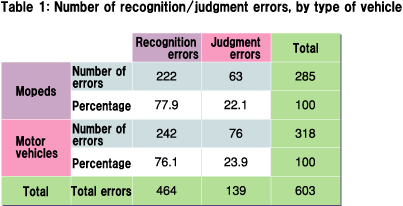
|
|
|
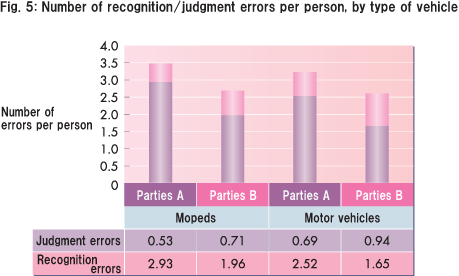
|
|
3-2-1 Classification of recognition/judgment errors
The number of recognition/judgment errors is summarized in Table 1 for mopeds and four-wheeled vehicles (hereinafter "motor vehicles") (total of Parties A and Parties B). Recognition errors made by drivers of both vehicle types account for over 70%. This means that accidents are mostly caused by initial-stage errors in recognizing the presence of objects before judging what action to take.
|
Figure 5 shows the number of recognition/judgment errors per person. Comparing the total recognition/judgment errors committed by Parties A and that of Parties B, the former is 1.2 to 1.3 times higher than the latter, which can be naturally explained by the definition of Party A. On the contrary, Parties B commit about 1.3 times more judgment errors than Parties A for both mopeds and motor vehicles. These results suggest that most traffic accidents would not have occurred if Parties A had not committed an error, and that most collisions could have been prevented if Parties B had tried to avoid a possible accident (i.e., defensive driving).
|
3-2-2 Analysis of recognition errors against a crossing vehicle
Recognition errors against crossing vehicles can be broadly classified as "believing there wouldn't be any crossing vehicles", "difficult to see the crossing vehicle", "lowered concentration", and "taking eyes off the road". "Believing there wouldn't be any crossing vehicles" refers to, for example, the assumption that "there won't be any vehicles present, because this is the road I frequently use and I have never seen any cars passing this intersection". "Difficult to see the crossing vehicle" refers to having had trouble recognizing the presence of the vehicle because it was concealed by something or it was fairly small, even though you tried to do so. Of these four categories, "difficult to see the crossing vehicle" and "lowered concentration" is specifically analyzed here.
|
[Difficult to see the crossing vehicle]
The factors contributing to the error "difficult to see the crossing vehicle" committed by motor vehicle drivers as Party A are shown in Fig. 6, by the approaching direction of the crossing vehicle (moped). The number of errors per driver against crossing vehicles coming from the right is higher than that against vehicles coming from the left. The most common factor is "concealed by house, fence, trees, etc.", followed by "concealed by another vehicle" and "outside the range of the traffic mirror", as well as "(the moped was) not conspicuous". "Others" include the moped being concealed by a guard rail, construction fence, the front pillar of the driver's own car, etc. These factors lead to speculation that mopeds are so small that they can easily be concealed by various things, resulting in errors on the side of Party A leading to an accident. In addition, in half the collisions with mopeds coming from the right, the moped was overlooked because it was running near the left edge of the road.
|
[Lowered concentration]
"Lowered concentration" can be roughly classified into intrinsic factors such as "absentminded", "distracted" and "in a hurry", and extrinsic factors like distracted by something outside the car. The intrinsic factors are listed in Fig. 7 by type of vehicle (total of Parties A and Parties B). It is revealed that moped drivers are more likely to suffer from lowered concentration compared to drivers of motor vehicles. The most common factor in moped drivers is "daydreaming/absentminded", followed by "in a hurry".
|
|

|
|
|
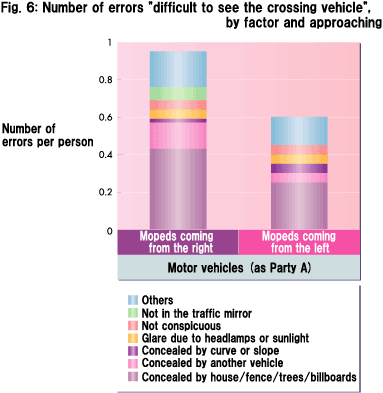
|
|
|
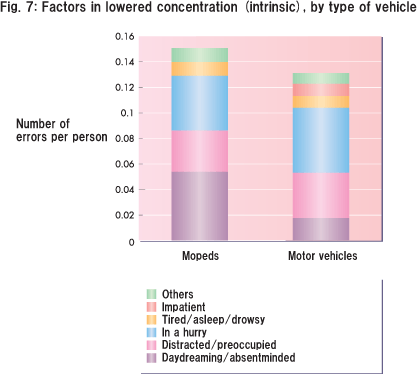
|
|
Figure 8 lists the extrinsic factors by type of vehicle (total of Parties A and Parties B). Unlike the case of intrinsic factors, the concentration of motor vehicle drivers is more frequently lowered compared to that of moped drivers.
The most common and characteristic reason is "attention focused on the opposite side to the other party", followed by "attention focused on vehicles other than the other party". From this data, drivers of motor vehicles presumably pay attention to other things because mopeds are not conspicuous.
|
|

|
|
|
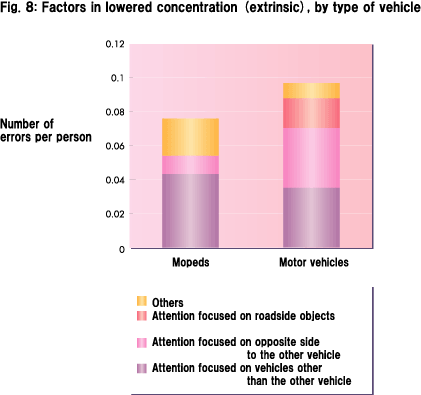
|
|
3-2-3 Analysis of judgment errors against crossing vehicles
Now that the factors of recognition errors have been analyzed, we look into inappropriate judgments made after recognizing the presence of the other party. As explained earlier (see Fig. 5), judgment errors are different from recognition errors in that the number of error factors per person affecting Parties B is higher than that of Parties A. Hence, the analysis is centered on Parties B.
In Fig. 9, we have summarized the factors leading Parties B to incorrectly judge that they can proceed first at an intersection. The main factor is "seen by the other driver also", followed by "green light or right of way" and other factors such as "the other vehicle seemed to decelerate or stop". In other words, Parties B form judgments on the other vehicle's movement in their favor in most judgment errors.
Successful recognition of the presence of another vehicle at an intersection does not necessarily mean that the other driver also recognizes your presence. Accidents can thus be avoided by defensive driving, e.g., by preparing for a sudden movement of the other party and decelerating as necessary.
|

|
|
|
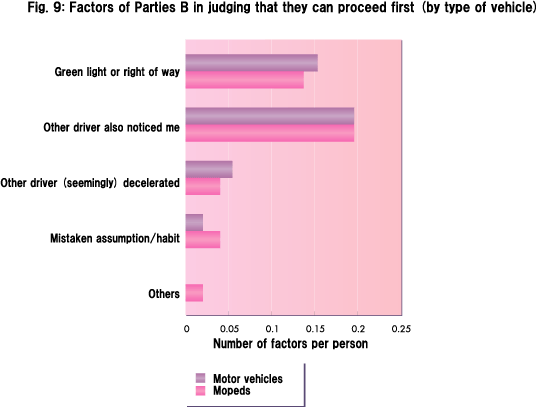
|
|
|
UP
Back Next
|
